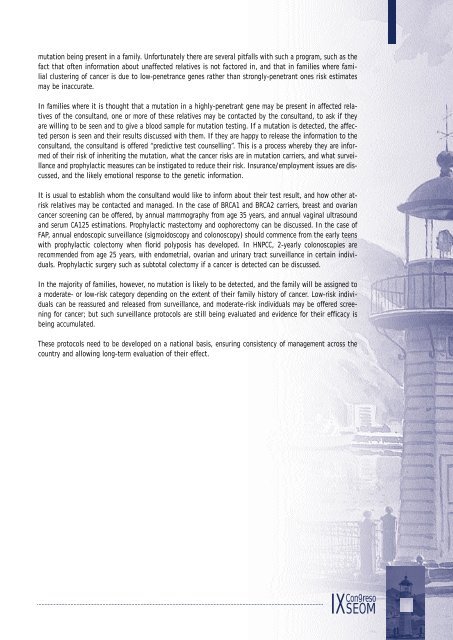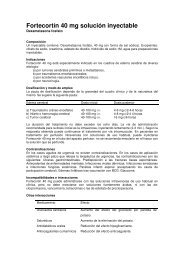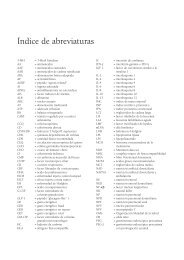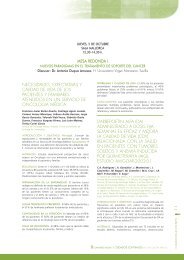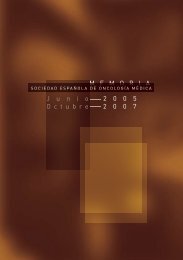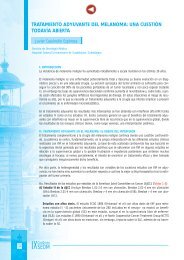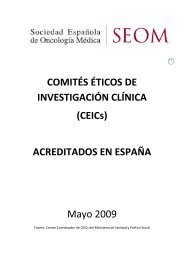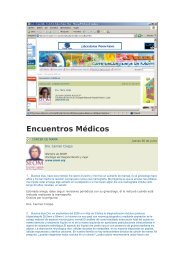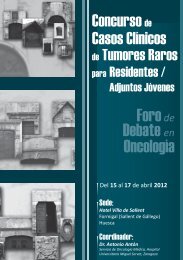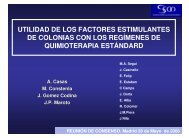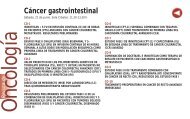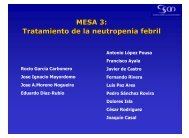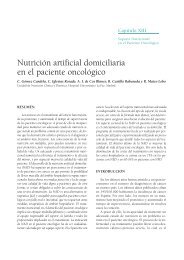Resúmenes de Ponencias - Sociedad Española de OncologÃa Médica
Resúmenes de Ponencias - Sociedad Española de OncologÃa Médica
Resúmenes de Ponencias - Sociedad Española de OncologÃa Médica
You also want an ePaper? Increase the reach of your titles
YUMPU automatically turns print PDFs into web optimized ePapers that Google loves.
mutation being present in a family. Unfortunately there are several pitfalls with such a program, such as the<br />
fact that often information about unaffected relatives is not factored in, and that in families where familial<br />
clustering of cancer is due to low-penetrance genes rather than strongly-penetrant ones risk estimates<br />
may be inaccurate.<br />
In families where it is thought that a mutation in a highly-penetrant gene may be present in affected relatives<br />
of the consultand, one or more of these relatives may be contacted by the consultand, to ask if they<br />
are willing to be seen and to give a blood sample for mutation testing. If a mutation is <strong>de</strong>tected, the affected<br />
person is seen and their results discussed with them. If they are happy to release the information to the<br />
consultand, the consultand is offered “predictive test counselling”. This is a process whereby they are informed<br />
of their risk of inheriting the mutation, what the cancer risks are in mutation carriers, and what surveillance<br />
and prophylactic measures can be instigated to reduce their risk. Insurance/employment issues are discussed,<br />
and the likely emotional response to the genetic information.<br />
It is usual to establish whom the consultand would like to inform about their test result, and how other atrisk<br />
relatives may be contacted and managed. In the case of BRCA1 and BRCA2 carriers, breast and ovarian<br />
cancer screening can be offered, by annual mammography from age 35 years, and annual vaginal ultrasound<br />
and serum CA125 estimations. Prophylactic mastectomy and oophorectomy can be discussed. In the case of<br />
FAP, annual endoscopic surveillance (sigmoidoscopy and colonoscopy) should commence from the early teens<br />
with prophylactic colectomy when florid polyposis has <strong>de</strong>veloped. In HNPCC, 2-yearly colonoscopies are<br />
recommen<strong>de</strong>d from age 25 years, with endometrial, ovarian and urinary tract surveillance in certain individuals.<br />
Prophylactic surgery such as subtotal colectomy if a cancer is <strong>de</strong>tected can be discussed.<br />
In the majority of families, however, no mutation is likely to be <strong>de</strong>tected, and the family will be assigned to<br />
a mo<strong>de</strong>rate- or low-risk category <strong>de</strong>pending on the extent of their family history of cancer. Low-risk individuals<br />
can be reassured and released from surveillance, and mo<strong>de</strong>rate-risk individuals may be offered screening<br />
for cancer; but such surveillance protocols are still being evaluated and evi<strong>de</strong>nce for their efficacy is<br />
being accumulated.<br />
These protocols need to be <strong>de</strong>veloped on a national basis, ensuring consistency of management across the<br />
country and allowing long-term evaluation of their effect.<br />
Congreso<br />
IXSEOM<br />
177


